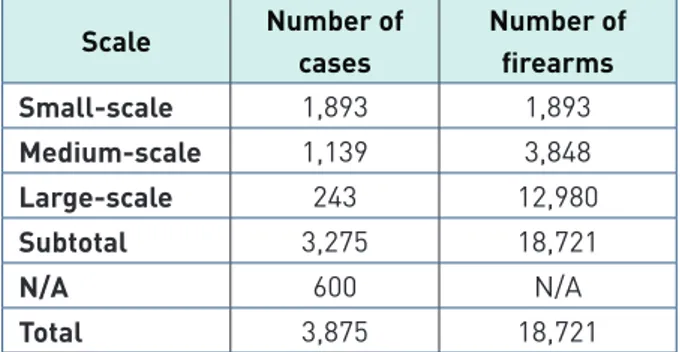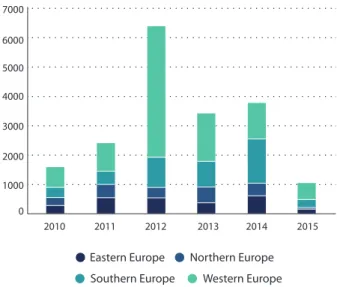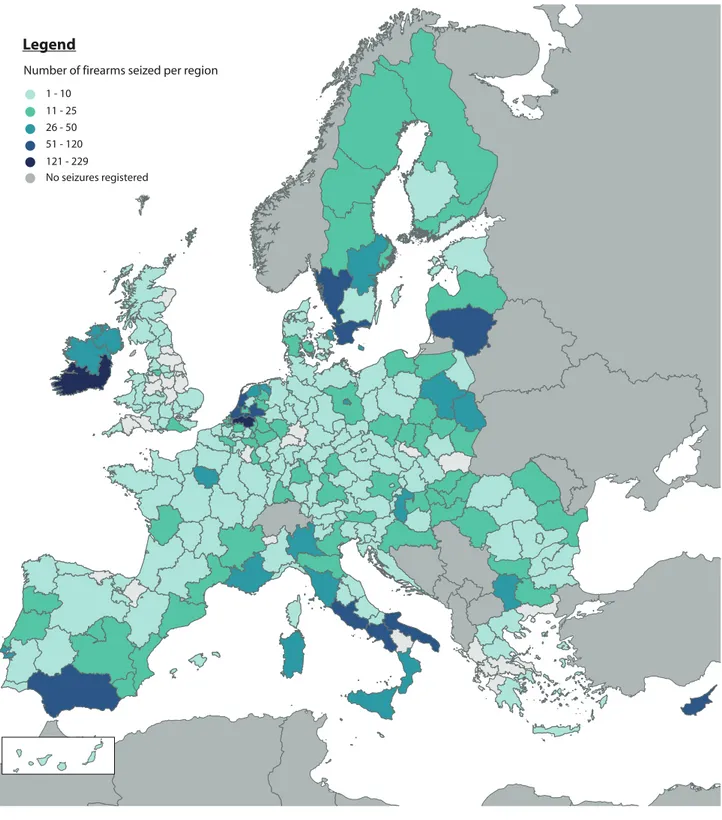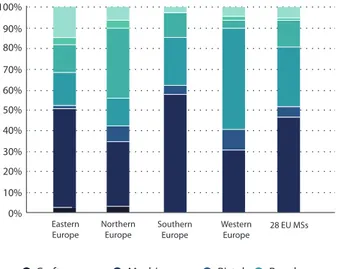Fighting Illicit
Firearms Trafficking
Routes and Actors
at European Level
Final Report of
Project FIRE
Co-funded by the Preventionof and Fight against Crime Programme of the European Union
Final Report of Project FIRE – Fighting Illicit firearms trafficking Routes and actors at European level (HOME/2013/ISEC/FP/C1/4000005009)
Edited by Ernesto U. Savona and Marina Mancuso
With the collaboration of (in alphabetical order): Monica Angelini; Ian Anthony; Anna Brener; Stefano
Caneppele; Carlotta Carbone; Daniele Ciminieri; Paolo Ciuccarelli; Marco Dugato; Serena Favarin; Lina Grip; Federica Daphne Ierace; Alexander Kamprad; Marta Lai; Michele Mauri; Margaux Morganti; Carlotta Parolo; Manjana Pecht; Azzurra Pini; Samuele Poy; Anna Raspa; Elisa Superchi; Chiara Zappaterreno; Mateja Zorc.
ISBN: 978-88-99719-03-6
Suggested citation: Savona Ernesto U. and Mancuso Marina (Eds.). 2017. Fighting lllicit Firearms
Trafficking Routes and Actors at European Level. Final Report of Project FIRE (www.fireproject.eu). Milano: Transcrime – Università Cattolica del Sacro Cuore © 2017.
Credits: grandeduc, eskaylim, pavrich
Graphic project: Ilaria Mastro (Transcrime – Università Cattolica del Sacro Cuore)
This project has been funded with the support of the European Commission. This publication reflects the views only of the author, and the European Commission cannot be held responsible for any use which may be made of the information contained therein.
List of tables List of figures List of boxes
List of acronyms and abbreviations Acknowledgements
Executive summary 1. Introduction
1.1. Project FIRE
1.2. Background and contribution of Project FIRE 1.3. Definitions of firearms and ITF
1.4. Structure of the report PART I. ITF in the EU
2. Illicit supply chain of firearms and modi operandi 2.1. Sources of illicit firearms
2.1.1 Firearm diversion 2.1.2 Firearm conversion 2.2. Wholesale of illicit firearms 2.3. Retail of illicit firearms
2.4. Characteristics of actors in firearm seizures 3. Demand for illicit firearms
3.1. Characteristics of shooters using illicit firearms 3.2. Use of illicit firearms in shootings in the EU 4. Illicit firearms trafficked in the EU
4.1. Numbers and types of firearms seized 4.2. Illicit firearms used in shootings in the EU 5. ITF routes
5.1. Supplying countries 5.2. Transit countries 5.3. Destination countries 6. Illicit firearms-related harm 7. Cross-cutting issues
7.1. The “grey area” in ITF
7.2. An emerging firearms market: The dark web
9 9 10 11 13 14 20 20 20 22 23 24 27 27 29 30 33 36 36 39 40 42 49 49 55 56 56 57 57 58 62 62 64
Table of contents
PART II. The EU’s regulatory framework to counter ITF 8. Overview of the EU regulatory framework
8.1. 1991 Firearms Directive
8.2. 2008 amendment of the Firearms Directive 8.3. Regulation No 258/2012
8.4. The 2015 EU Deactivation Regulation
8.5. The 2015 EC Proposal for amending the Firearms Directive
9. Crime Proofing of the 2015 EC Proposal for amending the Firearms Directive 9.1. Initial Screening: The first step
9.2. Preliminary Crime Risk Assessment: The second step 9.3. Extended Crime Risk Assessment: The third step
9.4. Results of the Crime Proofing analysis of the 2015 EC Proposal for amending the Firearms Directive
PART III. Recommendations on how to improve the prevention of and fight against ITF 10. Recommendations
11. Conclusions References
Chapter 1: Marina Mancuso and Alexander Kamprad (Università Cattolica del Sacro Cuore -Transcrime) Chapter 2: Elisa Superchi and Alexander Kamprad (Università Cattolica del Sacro Cuore - Transcrime) Chapter 3: Alexander Kamprad and Elisa Superchi (Università Cattolica del Sacro Cuore - Transcrime);
Ian Anthony, Lina Grip and Manjana Pecht (Stockholm International Peace Research Institute) Chapter 4: Elisa Superchi and Alexander Kamprad (Università Cattolica del Sacro Cuore - Transcrime).
With the collaboration of Serena Favarin (Università Cattolica del Sacro Cuore - Transcrime) Chapter 5: Elisa Superchi and Carlotta Carbone (Università Cattolica del Sacro Cuore-Transcrime) Chapter 6: Alexander Kamprad (Università Cattolica del Sacro Cuore - Transcrime)
With the collaboration of Marco Dugato (Università Cattolica del Sacro Cuore - Transcrime) Chapter 7: Alexander Kamprad and Carlotta Carbone (Università Cattolica del Sacro Cuore - Transcrime) Chapter 8: Ian Anthony, Lina Grip and Manjana Pecht (Stockholm International Peace Research Institute);
Margaux Morganti (Università Cattolica del Sacro Cuore - Transcrime)
Chapter 9: Margaux Morganti and Marina Mancuso (Università Cattolica del Sacro Cuore - Transcrime). With the collaboration of Anna Brener (Università Cattolica del Sacro Cuore - Transcrime)
Chapter 10: Margaux Morganti, Elisa Superchi, Alexander Kamprad and Marina Mancuso (Università Cattolica del Sacro Cuore -Transcrime)
Chapter 11: Marina Mancuso (Università Cattolica del Sacro Cuore - Transcrime)
Authors
68 69 69 70 74 75 75 78 78 85 91 98 99 100 106 10749 The experts interviewed underlined that converted
firearms are more frequently trafficked than second-hand firearms and new firearms. The most widespread brands are Turkish Atak Zoraki and Ekol/Voltran (De Vries 2012; Ferguson and Williams 2014; King 2015). Interviewees also stressed the role of second-hand firearms, often stolen, among trafficked firearms. This generally refers to revolvers, handguns, small pistols, and hunting rifles easy to exchange because of their technical characteristics. New artisan firearms are trafficked as well. There is very little information on the issue, except for Europol’s report that points out that “cheap Bulgarian hand-made weapons can be sold in Greece, the Netherlands, Spain, and Turkey for a profit of 800%” (Europol 2005, 24).
In regard to specific firearm models, the literature gives only sporadic information. Two types of firearms are frequently mentioned as products illicitly trafficked: Uzi-type firearms (Spapens 2007) and AK-type rifles (Arsovska and Zabyelina 2014; Biggs 2011; Curtis and Karacan 2002; Killicoat 2006; Pyadushkin, Haug, and Matveeva 2003; Sagramoso 2001; Schroeder and King 2012; Spapens 2007). With regard to Uzi-type firearms, during the wars in former Yugoslavia many small Croatian factories produced exact copies of the Uzi-type which ended up in the illicit markets (Spapens 2007). Focusing on the AK-type rifles, they are among the most trafficked weapons because they are easy to use and to repair, and also cheap.27 Moreover, they are very
robust, durable and reliable, and highly lethal. They were created to be easily managed by Soviet soldiers in arctic weather conditions, and they can be stored in bad conditions or not be properly maintained and still perform perfectly. As a consequence, these weapons are used in almost all insurgencies (Biggs 2011; Killicoat 2006).
4. Illicit firearms trafficked in the EU
Besides illicit firearms trafficked in the EU, there is also an unknown number of firearms kept without a licence. Such stocks include for example inherited weapons or weapons for which the original licence has expired (Bricknell 2012). There have also been cases, for example in Belgium, where a change in legislation has rendered many firearms illicit unless they are subsequently registered with the police. Renewing a licence or having a weapon deactivated or destroyed usually involves a fee and an administrative process. When there is no criminal use of the weapon, these illicit weapons tend to be of low priority to LEAs. Some of these weapons surface during gun amnesties because the owners can voluntarily turn them over to the police without fear of prosecution.28
The following sections discuss the results on firearms seized (Section 4.1) and illicit firearms used in deadly and non-deadly shootings (Section 4.2). Both sets of results are obtained from the analysis of open sources, i.e. online press articles and online press releases, in 28 EU MSs from January 2010 to March 2015 (see Methodological Annex for details). They have been used as proxies for the products illicitly trafficked in the EU.
4.1. Numbers and types of firearms
seized
According to the open sources collected, most seizures concerned only firearms (53%) and
‘firearms and ammunitions’ (46%). Exclusive seizures of ammunitions were comparatively rare (1% of all seizures). Most cases of firearm seizures are small-scale, i.e. they involve 1 firearm. This result confirms what has already been stressed in the literature: firearms are durable goods, so that the demand is
27. A recent study reported that a new AK-47 costs only around USD 200 (Arsovska and Zabyelina 2014). Their original design is no longer produced in Russia, but Russian factories produced similar rifles (i.e. the AK-101 to 108 series) and 29 other countries produced the original one at the beginning of the 2000s (Brömmelhörste et al. 2002; Pyadushkin, Haug, and Matveeva 2003).
28. In 2013, the Swedish police received 15000 illegal weapons during a period of three months during a gun amnesty (Polisen 2015).
50
not continuous (Arsovska and Zabyelina 2014; Greene 2000a; Grillot 2011; Hillier and Wood 2003; Joseph and Susiluoto 2002; Spapens 2007; UNODC 2010). Although only a limited number of cases are large-scale trafficking (i.e. more than 10 firearms seized), they account for the majority of firearms seized: 243 seizures corresponding to almost 13,000 firearms seized (Table 4).
Table 4. Number of seizures and firearms seized in the EU per scale of seizure (2010-2015)*
Scale Number of cases Number of firearms Small-scale 1,893 1,893 Medium-scale 1,139 3,848 Large-scale 243 12,980 Subtotal 3,275 18,721 N/A 600 N/A Total 3,875 18,721
* For 2015, only first three months
Source: Transcrime elaboration of DFS-EU data (see Methodological Annex for details)
The overall average of firearms per seizure was 5.58. Analysis of European macro-regions between 2010 and 2015 shows that the average was highest in Western Europe and lowest in Northern Europe. Here most cases resulted in the seizure of 1 firearm. The highest number of firearms seized in one seizure was 3,261, which regarded a case in Western Europe.
Specifically, in 2012 the Austrian police found in a Chinese woman’s warehouse 3,261 airsoft guns, together with numerous knives, machetes, and other prohibited weapons. The firearms originated in China and some of them had been declared as toys. The maximum numbers of firearms per seizure were significantly lower in the other macro-regions (Table 5).29
Figure 16 and Figure 17 show the share of firearm seizures per macro-region and the number of firearms seized per macro-region and year. Western Europe is the region in which the majority of firearm seizures occurred, in terms of both cases (35.17% of EU total) and firearms seized (51.19% of EU total). Most of the cases in Western Europe occurred in the Netherlands (40.72% of cases, 7.69% of firearms), followed by Germany (27.22% of cases, 25.21% of firearms) and France (16.51% of cases, 10.83% of firearms). Most firearms, however, were seized in Austria (4.99% of cases, 41.19% of firearms), followed by Germany and Belgium (9.24% of cases, 14.83% of firearms).
Southern Europe is the region with the second largest amount of firearms seized (25.65% of cases and 24.03% of firearms of EU total). Within Southern Europe, Italy accounted for the most seizures (49.60% of cases, 39.28% of firearms), and Spain for the most firearms seized (30.18% of cases, 48.55% of firearms). The third largest amount of seizures occurred in Portugal (6.94% of cases, 4.51% of firearms seized).
Table 5. Minimums, averages, and maximums of firearms seized in the EU per macro-region (2010-2015)*
Macro-region Min. 1st Qu. Median Mean 3rd Qu. Max. N/A
Eastern Europe 0 1 1 4.32 3 300 119
Northern Europe 0 1 1 2.89 2 104 87
Southern Europe 0 1 2 5.02 4 239 98
Western Europe 0 1 1 8.39 2 3,261 221
28 EU MSs 0 1 1 5.59 3 3,261 525
* For 2015, only first three months
Source: Transcrime elaboration of DFS-EU data (see Methodological Annex for details)
29.Minimums of ‘0’ in Table 5 indicate cases in which only ammunitions but no firearms were seized.
51 Northern Europe is the macro region with the third
largest number of cases of firearm seizures (20.88% of cases and 11.15% of firearms of EU total). Within Northern Europe, the largest number of cases occurred in Sweden (33.62% of cases, 20.79% of firearms), followed by Ireland (33.25% of cases, 19.68% of firearms) and the UK (14.59% of cases, 20.93% of firearms). In terms of firearms seized, however, Denmark accounted for the highest number (11.12% of cases, 33% of firearms), followed by the UK and Sweden.
The smallest number of cases of firearm seizures occurred in Eastern Europe (18.30%). These cases of seizures account, however, for 13.63% of the total firearms seized in the EU. Eastern Europe thus surpasses Northern Europe in terms of the number of firearms seized. The largest number of cases within Eastern Europe occurred in Poland (36.11% of cases, 51.16% of firearms), followed by Hungary (19.32% of cases, 9.06% of firearms) and Bulgaria (14.25% of cases, 8.94% of firearms). Poland also accounted for the largest number of firearms seized, followed by Romania (12.98% of cases, 15.25% of firearms) and Bulgaria.
Figure 17 shows that most firearms were seized in 2012, followed by 2014 and 2013.30 The high number of
firearms seized in 2012 relates to the aforementioned case of 3,261 firearms seized in Austria.
Figure 16. Seizures in the EU per macro-region (2010-2015)*
Figure 17. Number of firearms seized in EU per macro-region and year (2010-2015)*
Eastern Europe Western Europe Northern Europe Southern Europe 35% 26% 18% 21%
* N=18,721. For 2015, only first three months Source: Transcrime elaboration of DFS-EU data (see Methodological Annex for details)
30. The number of firearm seizures recorded in 2015 is comparatively low because only cases occurring before March 31st found entry into
the database. 2010 2011 2012 2013 2014 2015 0 1000 2000 3000 4000 5000 6000 7000 Eastern Europe Western Europe Northern Europe Southern Europe
* N=11,671. For 2015, only first three months Source: Transcrime elaboration of DFS-EU data (see Methodological Annex for details)
Figure 18 shows that the number of firearms seized varied not only per macro-region but also within countries. Usually, high numbers of firearms were seized along borders and in proximity to the main ports. Also, the presence of OCGs is likely to influence the distribution of firearm seizures across regions. These groups on the one hand have expertise in trafficking all sorts of illicit goods, and on the other they need firearms to perpetrate illicit activities (Calderoni et al. 2014; Massari 2013; Paoli 2013; Ruggiero 1997). Figure 19 reports the ratio of firearms seized per region calculated on 100,000 inhabitants.
52
Figure 18. Number of firearms seized in the EU per region (NUTS 2) (2010-2015)*
1 - 10 11 - 25 26 - 50 51 - 120 121 - 229 No seizures registered
Legend
Number of firearms seized per region
* For 2015, only first three months
53
Figure 19. Rate of firearms seized in the EU per 100,000 inhabitants per region (NUTS 2) (2010-2015)*
* For 2015, only first three months
54
Most firearms seized were found indoors in residential buildings (63%), followed by vehicles (17%), while all other types of storage accounted for less than 2% each (Figure 20).31 This applies to
all macro-regions (Figure 21). The high number of firearm seizures occurring in residential buildings and vehicles suggests that illegally kept firearms are typically kept close to the owners’ area of influence. Results from case studies support this result: in most of the investigations considered, criminal groups tended to store the firearms in private houses. This result may show that criminals prefer to have firearms readily available and to exercise closer supervision over them. The shares also reflect the nature of police searches, which typically occur in residential buildings and vehicles. Firearm seizures in vehicles may be indicative of the so-called “ant trade”, i.e. the smuggling of one or a few firearms and accumulating over time (Cukier 2008; Hillier and Wood 2003; KLPD—IPOL 2009; Seniora and Poitevin 2010). This mode of trafficking is hard to identify precisely because it is difficult to distinguish it from mere cases of illegal firearm possession.
Figure 20. Storage of firearms seized in the EU (2010-2015)*
31. The other category includes places identified by the analysis as other possible storage places, e.g. in streets, hotels, and shopping centres.
32. The classification of firearm types is based on the Study on Firearms by UNODC (2015). The other category includes: replicas, air guns, gas pistols, and antique firearms (more details in the Methodological Annex).
* N=2,929. For 2015, only first three months Source: Transcrime elaboration of DFS-EU data (see Methodological Annex for details)
Figure 21. Storage of firearms seized in the EU per macro-region (2010-2015)*
* N=2,929. For 2015, only first three months Source: Transcrime elaboration of DFS-EU data (see Methodological Annex for details)
Regarding the types of firearms, throughout all regions the majority of seizures involve pistols (34%) and rifles (27%), while all other categories account for less than 10% each.32 Rifles are more frequently
seized in Eastern and Western Europe, while pistols are more frequently seized in Northern and Southern Europe. Except for larger shares of shotguns seized in Northern Europe, the shares of all other firearm types are comparatively small (Figure 22).
Owing to a lack of more recent data, this finding can only be compared to available data on types of firearms owned. These data make no distinction between legally and illegally held firearms, and they were gathered in the 2004/2005 round of the ICVS. On the basis of these data, Duquet and Van Alstein (2015a) reported that in most European countries long guns account for the largest share of firearm types owned. The larger share of seized pistols reflected in the data collected from open sources points to a different composition of firearm types that are owned illicitly. Handguns (pistols or revolvers) are portable, and they are easier to use and conceal than long guns (Marsh 2015).
0% 10% 20% 30% 40% 50% 60% 70% 80% 90% 100% Eastern
Europe Western Europe 28 EU MSs Northern
Europe
Southern Europe
Car Farm Garage House Warehouse Other
Car Farm Garage House Warehouse Other
17%
63%
2% 1%
15%
55
33. The other category comprises: replicas, air guns, gas pistols, and antique firearms. This classification is based on the Study on Firearms by UNODC (2015).
Figure 22. Types of firearms seized in the EU per macro-region (2010-2015)* 0% 10% 20% 30% 40% 50% 60% 70% 80% 90% 100% Eastern
Europe Western Europe 28 EU MS Northern
Europe
Southern Europe
Craft weapon
Submachine gun Other Machine gun Pistol Revolver Rifle Shotgun
* N=11,671. For 2015, only first three months Source: Transcrime elaboration of DFS-EU data (see Methodological Annex for details)
4.2. Illicit firearms used in shootings
in the EU
The illicit demand for one firearm type or another is eventually driven by the intended use. According to the newspaper articles collected, almost half of the illicit firearms used in shootings in the EU were pistols (Figure 23).33 In developed countries,
handguns are the most common type of firearm acquired for use in criminal endeavours, since the longer range of rifles is not usually needed (Marsh 2015). Rifles account for the second largest share of firearm types: certain types of shootings, especially for socio-political purposes, may favour the use of the higher fire power of long guns over firearms that are easier to conceal. This holds especially true for assault rifles. Hunting rifles, on the other hand, may instead be illicitly owned for private purposes, for example by hunters and gun collectors, and be used in family/intimate partner and interpersonal shootings.
A division by macro-region shows that the shares by types of firearm used in shootings vary among different parts of Europe. High shares of pistols are used in Southern and Eastern Europe. Western Europe instead records a larger amount of rifles, while Northern Europe shows a particularly high proportion of shotguns. These differences in part result from the different distributions of types of shootings among the macro-regions. The choice of firearms depends on the context in which they are needed and on their availability. A report based on survey data shows how shares of types of firearms owned vary from country to country (Duquet and Van Alstein 2015a). While the findings are irrespective of whether firearms are legal or illicit, this pattern is likely to influence also the illegal gun market at national and regional level.
Figure 23. Types of firearms used in shootings in the EU per macro-region (2010-2015)* 28 EU MSs 0% 10% 20% 30% 40% 50% 60% 70% 80% 90% 100% Eastern
Europe Northern Europe Southern Europe
Western Europe
Craft weapon
Submachine gun Other Machine gun Pistol Revolver Rifle Shotgun
* N=1,973 (only shootings with illicit firearms). For 2015, only first three months
Source: Transcrime elaboration of DSh-EU data(see Methodological Annex for details)
The next chapter presents the main routes used to traffic firearms illicitly in the EU.



